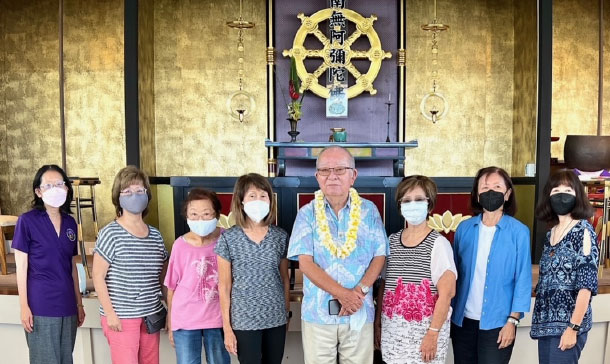Have you seen the flyer announcing an Open Call for Haiku Submissions? The flyer encourages statewide participation of Honpa Hongwanji Sangha members and families. The theme is the 2022 HHMH slogan, “Building Healthy Sanghas: Connecting with Others” and the sub theme is “What Would Shinran Do or Say?” Haiku poems may be accompanied by original digital photos or photos of original drawings/art.
Submissions are to be emailed to BJ Soriano at bj@bjsoriano.com and the deadline is August 31, 2022. The collected submissions are expected to be shared statewide at the end of 2022.
In response to the Open Call for Haiku Submissions, some BWA members suggested seeking guidance from retired Honpa Hongwanji minister Rev. Ryoso Toshima, Sensei of the Japanese class at Hawaii Betsuin and past Rimban of Hawaii Betsuin. Rev. Toshima majored in literature during his undergraduate days at Ryukoku University and he writes one haiku every day.

Participants in haiku poetry session on June 22, 2022.
Rev. Toshima happily accepted Florence Wasai’s invitation to lead a haiku poetry session. The morning of June 22, BWA President, Cindy Alm, welcomed him with a plumeria lei and Wendie Yumori thanked Rev. Toshima for coming to share his approach to writing haiku. At the beginning of his remarks, he put everyone at ease by saying, “Haiku is not hard.” He spoke of his daily strolls downtown, the folks he speaks with regularly, and the sights he encounters along the way. He said that the process of composing a haiku poem is similar to that of composing elements of a photo with a camera. Rev. Toshima noted that his mind has become accustomed to structuring his impressions in lines of 5 – 7 – 5 for the 17 syllables of a haiku poem.
Rev. Toshima then led everyone in a simple exercise. He passed out blank slips of paper and asked each participant to write down 5 syllables on the first slip of paper, 7 syllables on a second slip, and 5 on a third. The three slips submitted by each participant did not have to be related in meaning. These collected slips comprised piles 1, 2, and 3. Rev. Toshima shuffled each stack of slips and then selected one slip from each pile to create a composite haiku.
Here are two examples of such composite haikus. How interesting to note that, even though the lines were randomly chosen from the three piles, the haikus conveyed a meaning that resonated. After the haikus were put together in English, Rev. Toshima and participants translated the lines into Japanese in 5 – 7 – 5 structure.
Namo Amida Butsu
It’s the bluest sky
Namo Amida Butsu
Aoi sora
Together, we try to write
Come just as you are
Isshoni kakimasho
Sono mama de
This paper and pencil exercise was a great way to dive into creating 5 – 7 – 5 lines. It was spontaneous, fun, and freeing — a way of being in the 5 – 7 – 5 moment! Sangha friends and families could easily engage in such an activity and may eventually focus on the theme or sub theme of the flyer. Warmest mahalo to Rev. Ryoso Toshima for easing folks into the process of writing haiku and much appreciation to Sensei for his kind offer to speak “anytime” about haiku, a subject dear to his heart.
Submitted by Wendie Yumori


